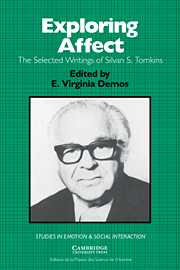Book contents
- Frontmatter
- Contents
- Foreword
- Editor's preface
- List of contributors
- Chronology
- Introduction
- Part I Affect theory
- Introduction
- Selections by Silvan S. Tomkins
- Part II Affect and ideology
- Introduction
- Selections by Silvan S. Tomkins
- Part III The face of affect
- Introduction
- Selections by Silvan S. Tomkins
- Part IV Script theory: The differential magnification of affect
- Introduction
- Selections by Silvan S. Tomkins
- Part V Human being theory: A foundation for the study of personality
- Introduction
- Selections by Silvan S. Tomkins
- The cognitive system
- Simulation of personality: The interrelationships between affect, memory, thinking, perception, and action
- Personality theory and social science
- A complete annotated bibliography of Silvan S. Tomkins's writings
- References
- Author index
- Subject index
- Titles in the series
The cognitive system
Published online by Cambridge University Press: 10 November 2010
- Frontmatter
- Contents
- Foreword
- Editor's preface
- List of contributors
- Chronology
- Introduction
- Part I Affect theory
- Introduction
- Selections by Silvan S. Tomkins
- Part II Affect and ideology
- Introduction
- Selections by Silvan S. Tomkins
- Part III The face of affect
- Introduction
- Selections by Silvan S. Tomkins
- Part IV Script theory: The differential magnification of affect
- Introduction
- Selections by Silvan S. Tomkins
- Part V Human being theory: A foundation for the study of personality
- Introduction
- Selections by Silvan S. Tomkins
- The cognitive system
- Simulation of personality: The interrelationships between affect, memory, thinking, perception, and action
- Personality theory and social science
- A complete annotated bibliography of Silvan S. Tomkins's writings
- References
- Author index
- Subject index
- Titles in the series
Summary
Introduction to the second half of human being theory
I have, in Volumes I, II, and III, now completed the examination of the major motivational mechanisms: the homeostatic, the drive, the affect, and nonspecific amplification systems. This constitutes one-half of what I have called human being theory. My excursions into personality theory thus far have been episodic (Volume III, Chapter 3) rather than systematic because I will publish a theory of personality I have called script theory in volumes separate from this prolegomenon to personality theory. Human being theory is a part of what used to be called general psychology. I have relabeled it because general psychology has been abandoned as a consequence of increasing specialization and because I wish to provide a theory for understanding human beings rather than a more general theory for understanding all animals.
In this second half of human being theory I will examine what I have defined as the cognitive system. Before examining the nature of this system, let us briefly review some of the history of cognitive theory.
The cognitive revolution
We are in the midst of what has been called the cognitive revolution in psychology. New journals of cognition and cognitive science flourish, and editors and authors alike act as if there were no ambiguity about the nature of this relatively new field. In part this has happened because cognitive theory originated in intellectual combat.
- Type
- Chapter
- Information
- Exploring AffectThe Selected Writings of Silvan S Tomkins, pp. 425 - 440Publisher: Cambridge University PressPrint publication year: 1995



